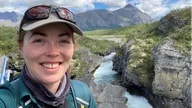Guest post - Nááts’įhch’oh National Park Reserve – Johanna Robson
Posted:
In a series of three blog posts, we are delighted to partner with Parks Canada to introduce you to three National Parks and three of the amazing women of STEM who are working together to meet the challenge of protecting these special places for present and future generations.
Everyone has heard of Jasper and Banff National Parks here in our own backyard, but what of the other 46 National Parks? A virtual pivot for TELUS World of Science Edmonton this past year allowed us to introduce experts and bring content from further afield to students in our province. One exciting partnership was developed with Park Canada’s Southwest NWT Field Unit, which encompasses four of our National Parks.
Nááts’įhch’oh National Park Reserve is the part of the traditional homelands of the Shúhtaot’ine (Mountain Dene) and Métis of the Sahtu region in the Northwest Territories. The Creator led the Shúhtaot’ine to make the mountains their home. Since time immemorial, they have been the keepers of the land, water, wildlife and sacred places. In 2012 the Sahtu Dene and Métis of the Tulita District and Parks Canada signed the Nááts’įhch’oh National Park Reserve Impact and Benefit Plan to co-operatively manage and protect the park area. The National Park Reserve derives it’s name from Mount Nááts’įhch’oh and forms the headwaters for the South Nahanni River.
For more information visit: www.pc.gc.ca/naatsihchoh
Meet Johanna Robson. She’s a Resource Conservation Specialist for Nááts’įhch’oh National Park Reserve!
Favourite part of the park?
So far my favourite place in Nááts’įhch’oh is Nı́onep'eneɂ Tué (Backbone Lake). This lake is at the bottom of a mountain valley with a well-worn wildlife highway and spectacular views. I enjoy rising to the challenge of the unpredictable weather that swells up in the valley and blasts out through the narrow pass onto the lake.
Best study you’ve gotten to work on?
The best part about ecological monitoring at Nááts’įhch’oh is that we are still in the beginning of collecting baseline data. The park is remote and difficult to access, so very few scientific studies have been done in the park area. We have started by collecting baseline data on ecological measures including water quality, air temperature and species presence. I am excited to see what patterns emerge in our data over the next few years.
Favourite part of your job?
One of my favourite parts of the job is travelling to remote sites to collect field data. The other exciting part of my job is when we rush back to the office to look at what the new data can tell us about ecological changes. I also really enjoy opportunities to share information about the park's ecology at community presentations, management meetings or in the local schools. At these events I often get to learn more about the history of Nááts’įhch’oh as well. I guess I love all parts of the job!
What do you love about Science?
I love the process of exploring new questions, testing our ideas and creating new knowledge about the relationships between plants, animals and the landscape. For me, it's really exciting to collect data and use it to identify the unique patterns and stories of an ecological community.
What kind of advice do you have for emerging young scientists?
Read and experiment a lot on any topic that interests you. Explore all the ideas you have, even when they lead to dead ends, these are learning opportunities. Learn to problem solve. When someone says it won’t work, don’t worry about it, many mistakes and failures make you an even better scientist. Speak up clearly and share your ideas and solutions. Learn to speak and write well so your amazing knowledge can be communicated with people that don’t understand. Don’t try to blend in, be yourself, be a woman who knows what she knows. Remember advice is cheap and often from someone else’s bias, you can ignore it if you want.
Doing what you love, even when it’s not popular, makes you a rebel, and what’s cooler than that?
Are you also interested in working in Conservation and Science jobs in Parks Canada?
Learn more about STEM careers in Parks Canada and many of our exciting projects by visiting: https://www.parkscanada.gc.ca/en/nature/science
Related Articles


Food Chain Reactions
How Climate Change is Impacting Canada's Lakes


It Is Ice to See You
How Seasonal Connections Are Affected by Climate Change


Getting to the Core of Climate Change
A Look at How Refrigerants Are Affecting Our Environment through Ice Cores
Related Articles


Food Chain Reactions
How Climate Change is Impacting Canada's Lakes


It Is Ice to See You
How Seasonal Connections Are Affected by Climate Change


Getting to the Core of Climate Change
A Look at How Refrigerants Are Affecting Our Environment through Ice Cores




